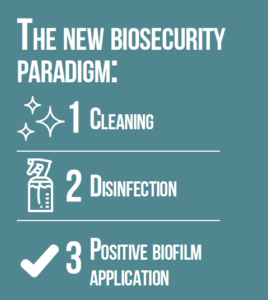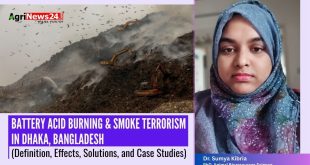 International desk: Nature abhors a vacuum. This adage is particularly true when it comes to microbial ecosystems. When looking at the hygiene management of farm buildings, we have to keep in mind that following cleaning and disinfection, surfaces do not remain sterile for long! This is when a positive biofilm approach begins to make sense. The idea is to apply selected beneficial bacteria along the building surfaces just after disinfection. By rapidly establishing a positive biofilm in the building cycle, it will leave less room for the undesirable microorganisms to grow (cf. figure 1).
International desk: Nature abhors a vacuum. This adage is particularly true when it comes to microbial ecosystems. When looking at the hygiene management of farm buildings, we have to keep in mind that following cleaning and disinfection, surfaces do not remain sterile for long! This is when a positive biofilm approach begins to make sense. The idea is to apply selected beneficial bacteria along the building surfaces just after disinfection. By rapidly establishing a positive biofilm in the building cycle, it will leave less room for the undesirable microorganisms to grow (cf. figure 1).
Successful applications in piglets…
 A trial in farrowing rooms (Italy, 2017), shows that a positive biofilm is promoted on the building surfaces compared to disinfection alone when positive biofilm product LALFILM PRO is sprayed on the walls and floors following cleaning and disinfection. Positive Pediococcus spp. populations were higher while the development of negative microorganisms (Staphylococcus spp. and Streptococcus spp.) were limited.
A trial in farrowing rooms (Italy, 2017), shows that a positive biofilm is promoted on the building surfaces compared to disinfection alone when positive biofilm product LALFILM PRO is sprayed on the walls and floors following cleaning and disinfection. Positive Pediococcus spp. populations were higher while the development of negative microorganisms (Staphylococcus spp. and Streptococcus spp.) were limited.
Another trial was carried out in piglets (France, 2017) with three consecutive batches of 2,318 piglets in a commercial farm. Again, the application of LALFILM PRO showed the formation of a positive microbial environment in the building, leading to a reduced development of undesirable bacteria in the animal environment (streptococci, coliforms), thanks to the biophysical barrier created by the positive biofilm.
… and poultry
In a trial conducted in a broiler barn (France, 2017), the application of LALFILM PRO showed the implementation of a positive microbial environment (Bacillus spp. and lactic acid bacteria). As a result, broiler performance was improved, including growth performance, homogeneity of light chicks, mortality and culling rates.
In conclusion
Farm biosecurity measures—including cleaning, disinfection, and application of sanitary breaks—impact the level of infection pressure before new animals enter the barn. Integrating a positive biofilm approach is shown to be an effective tool to complement these measures. It helps install a positive biofilm after the disinfection step and during the batch, which helps maintain a safe microbial environment within the farm for safer production conditions.

 Agrinews24 কৃষির সাথে, কৃষকের পাশে
Agrinews24 কৃষির সাথে, কৃষকের পাশে





















